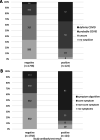Indicators of recent COVID-19 infection status: findings from a large occupational cohort of staff and postgraduate research students from a UK university
- PMID: 35945541
- PMCID: PMC9363143
- DOI: 10.1186/s12889-022-13889-0
Indicators of recent COVID-19 infection status: findings from a large occupational cohort of staff and postgraduate research students from a UK university
Abstract
Background: Researchers conducting cohort studies may wish to investigate the effect of episodes of COVID-19 illness on participants. A definitive diagnosis of COVID-19 is not always available, so studies have to rely on proxy indicators. This paper seeks to contribute evidence that may assist the use and interpretation of these COVID-indicators.
Methods: We described five potential COVID-indicators: self-reported core symptoms, a symptom algorithm; self-reported suspicion of COVID-19; self-reported external results; and home antibody testing based on a 'lateral flow' antibody (IgG/IgM) test cassette. Included were staff and postgraduate research students at a large London university who volunteered for the study and were living in the UK in June 2020. Excluded were those who did not return a valid antibody test result. We provide descriptive statistics of prevalence and overlap of the five indicators.
Results: Core symptoms were the most common COVID-indicator (770/1882 participants positive, 41%), followed by suspicion of COVID-19 (n = 509/1882, 27%), a positive symptom algorithm (n = 298/1882, 16%), study antibody lateral flow positive (n = 124/1882, 7%) and a positive external test result (n = 39/1882, 2%), thus a 20-fold difference between least and most common. Meeting any one indicator increased the likelihood of all others, with concordance between 65 and 94%. Report of a low suspicion of having had COVID-19 predicted a negative antibody test in 98%, but positive suspicion predicted a positive antibody test in only 20%. Those who reported previous external antibody tests were more likely to have received a positive result from the external test (24%) than the study test (15%).
Conclusions: Our results support the use of proxy indicators of past COVID-19, with the caveat that none is perfect. Differences from previous antibody studies, most significantly in lower proportions of participants positive for antibodies, may be partly due to a decline in antibody detection over time. Subsequent to our study, vaccination may have further complicated the interpretation of COVID-indicators, only strengthening the need to critically evaluate what criteria should be used to define COVID-19 cases when designing studies and interpreting study results.
Keywords: COVID-19; COVID-19 serological testing; Classification; Cohort studies; Public health.
© 2022. The Author(s).
Conflict of interest statement
The authors declare that they have no competing interests.
Figures
Similar articles
-
High Prevalence of Both Previous Infection with SARS-CoV-2 and Persistent Symptoms.J Am Board Fam Med. 2022 May-Jun;35(3):570-578. doi: 10.3122/jabfm.2022.03.210348. J Am Board Fam Med. 2022. PMID: 35641057
-
Mental health among UK university staff and postgraduate students in the early stages of the COVID-19 pandemic.Occup Environ Med. 2022 Apr;79(4):259-267. doi: 10.1136/oemed-2021-107667. Epub 2021 Oct 21. Occup Environ Med. 2022. PMID: 34675129
-
Retrospective analysis of seroprevalence in a cohort of university students of Rome (Italy) between September 2020 and July 2021.Epidemiol Prev. 2022 Sep-Dec;46(5-6):367-375. doi: 10.19191/EP22.5-6.A461.088. Epidemiol Prev. 2022. PMID: 36628641 English.
-
Thoracic imaging tests for the diagnosis of COVID-19.Cochrane Database Syst Rev. 2020 Nov 26;11:CD013639. doi: 10.1002/14651858.CD013639.pub3. Cochrane Database Syst Rev. 2020. Update in: Cochrane Database Syst Rev. 2021 Mar 16;3:CD013639. doi: 10.1002/14651858.CD013639.pub4. PMID: 33242342 Updated.
-
Seropositivity rate and diagnostic accuracy of serological tests in 2019-nCoV cases: a pooled analysis of individual studies.Eur Rev Med Pharmacol Sci. 2020 Oct;24(19):10208-10218. doi: 10.26355/eurrev_202010_23243. Eur Rev Med Pharmacol Sci. 2020. PMID: 33090430 Review.
Cited by
-
Systematic review of seroprevalence of SARS-CoV-2 antibodies and appraisal of evidence, prior to the widespread introduction of vaccine programmes in the WHO European Region, January-December 2020.BMJ Open. 2023 Nov 6;13(11):e064240. doi: 10.1136/bmjopen-2022-064240. BMJ Open. 2023. PMID: 37931969 Free PMC article.
References
-
- Davies NG, Kucharski AJ, Eggo RM, Gimma A, Edmunds WJ, Jombart T, et al. Effects of non-pharmaceutical interventions on COVID-19 cases, deaths, and demand for hospital services in the UK: a modelling study. Lancet Public Health. 2020;5(7):e375–e385. doi: 10.1016/S2468-2667(20)30133-X. - DOI - PMC - PubMed
-
- Neil Ferguson, Azra Ghani, Wes Hinsley, Erik Volz, Imperial College COVID-19 response team. Hospitalisation risk for Omicron cases in England. https://www.imperial.ac.uk/mrc-global-infectious-disease-analysis/covid-...: MRC Centre for Global Infection Disease Analysis; 2021. [Accessed 30 May 2022].
Publication types
MeSH terms
Grants and funding
LinkOut - more resources
Full Text Sources
Medical
Miscellaneous



